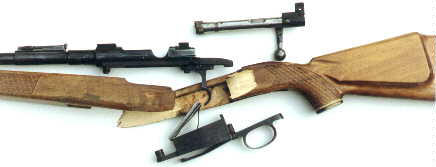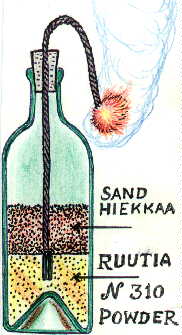<<
guns.connect.fi Link Page>> Gunwriters >>
Issue 4/2000 03.11.2000:
DEFLAGRATION, EXPLOSION and DETONATION:
Three rates of exothermic disintegration
by John R. (Austria)
As you know the guncotton has (nearly) 3 nitro groups (NO2) per cellulose molecule
(guncotton is a really extremely long molecule and therefore it is not exact
stochiometric). These nitro groups are from the nitric acid used in the nitration process.
Nitroglycerol is the ester of nitric acid and glycerol. Guncotton, Nitroglycerol and all
the other higher nitro compounds are in their pure form "high power explosives".
That means they are able to detonate. A detonation is by far more powerful than any
explosion.
For example black powder is impossible to detonate. What happens when black powder is
ignited is following: The fine sulphur and charcoal particles start burning, the generated
heat decomposes the potassium nitrate (it gives off pure oxygen "in nascent
state", as a very reactive free oxygen radical) and so the combustion of the
"fuel" gets faster and faster. When the gaseous reaction products are not able
to "fume off" the pressure and the temperature in the containment will rise
quickly. When the pressure goes up and reaches a point where the container can't hold more
it will explode. Note: The explosion is nothing more than a very rapid expansion of high
pressurized gas.
Nitroglycerol is in its pure form a colourless oily liquid with no odour. When you put a
few drops on a stone plate you can ignite them with a lighter. There will be nothing
dangerous, just a nice flame but no detonation or explosion. Put 1 - 2 (no more than
that!) drops on an anvil (wear ear and eye protection) and strike them directly with a
hammer: extreme loud and powerful detonation! All the higher nitro compounds or nitric
acid esters will react similar when treated that way. But what's now the difference
between detonation and explosion?
Well: these "high explosives", as they are called in the literature, all have
large amounts of chemically bonded oxygen in the molecule. If the amount of energy given
to the explosive is not too high it will start burning. This is called a "deflagration".
A greater mass of burning high order explosive can be very dangerous as it sometimes can
go off in detonation from one moment to another with nearly "no reason". When
more energy is given in a very rapid way (blasting cap) to the explosive, detonation
immediately starts. This is when the molecular structures break up and enormous amounts of
chemical bonded energy are set free by the decomposition of the nitro groups. The rest of
the molecule can be seen as "fuel" that reacts immediately with the oxygen from
the nitro group delivering even more energy. In some high order explosives the detonation
zone moves with a velocity of up to 8500 m/s through the explosive!
The explosives molecules hit by the detonation front are smashed to ions and extremely
reactive radicals ("loose" atoms; not yet bound together to be molecules like H2
or O2) and the whole thing gets plasma-like. Pressures go up to unbelievable 100 000 and
far more atmospheres! Another fact that is difficult to understand but very characteristic
for detonations is that the reaction products move directly to the detonation zone.

Every material (also - and especially - the hardest steel) is "atomized" to fine
particles when hit by this detonation wave. When the detonation is over and no explosive
is left, there are lots of reaction products (mostly H2O, CO2, CO, C, H2 and N) left. What
follows is the explosion (rapid expansion) of the reaction products. Comparing black
powder with dynamite is like comparing an airgun to a high power rifle.
NC powder consists of high order explosives with additions of phlegmatizers. The theory is
that the phlegmatizer is like a shield between the explosive molecules that slows down the
heat transfer and therefore the reaction. Usual NC powder is a mixture of highly nitrated
cellulose and low-nitrated cellulose. Highly nitrated guncotton contain ca. 13 % by weight
nitrogen, while low-nitrated collodion wool contain ca. 11 % N. Guncotton is almost
insoluble in the usual volatile powder solvent, mixture of ethyl ether and ethyl alcohol
while collodion wool is completely soluble, making syrup-like colourless liquid known as
collodion. Mixture of nitrated cellulose is moistened with a volatile solvent when NC
powder is produced. When the solvent is vaporized away, the powder contain
"hairs" or fibres of insoluble guncotton in the plastic-like "matrix"
of dissolved and hardened collodion wool. A solid powder kernel looks like composite
plastic. The very first plastic, celluloid, was actually dissolved (gelatinized) collodion
wool with some camphor added to make celluloid as elastic as the natural ivory, and less
brittle.
American brothers Hyatt invented celluloid in 1869 for billiard balls and piano
keys as an artifical ivory, which was easy to compression mould. In the original NC powder
was a matrix itself the phlegmatizer or shield between more explosive fibres of insoluble
guncotton. There were also some inorganic salts like potassium or barium nitrate added
into old NC powders giving more oxygen and "cooling down" deflagration of the
powder. Some old "semi-smokeless bulk shotgun powders" had those inorganic salts
only as the phlegmatizer. Mixture of guncotton, collodion wool and salts was compressed to
become thick sheets, like cardboard. The sheets were then grated to become irregular
grains and rounded in a rotating "candy drum". Just the surfaces of bulkpowder
kernels were gelatinized by spray of solvent to make them smooth and less prone to imbibe
humidity from ambient air.
Semi-smokeless shotgun powder is older invention than "dense" or gelatinized
smokeless rifle powder. Prussian artillery captain Schultze invented nitrated
sawdust of alder wood, impregnated with potassium and barium nitrates, in 1864. The
"sawdust powder" was too strong medicine for artillery pieces, but it became
soon popular as a shotgun powder. Captain Schultze established his powder plant to the
country of shotgunners, England. German Max Duttenhofer discovered the first
practical semi-smokeless military rifle powder in 1884. This Rottweiler Cellulose
Pulver was nitrolignine & nitrocellulose mixture, nitrated brown charcoal of
alderwood, but it was thoroughly gelatinized.
Frenchman Paul Vieille invented a more stable gelatinized smokeless rifle powder
in 1886, a mixture of guncotton and collodion wool, containing no more nitrolignine.
Russian chemist Dimitri Mendeleyev discovered the optimal ratio of soluble and
insoluble grades of nitrocellulose (with nitrogen content 12.6 %) in 1890 and "the
Mendeleyev's Principle of Controlled Deflagration" in 1891. Swedish Alfred Nobel
and Britons Abel and Noble designed powders like Ballistite and Cordite
in the late 1880s by use of nitroglycerol as a solvent of nitrocellulose. The original
mixture was Gelignite or gelatinized dynamite with up to 60 % percentage of nitroglycerol
- a high explosive - but just a slight addition of some organic phlegmatizer like
"mineral jelly" a.k.a. Vaseline is able to tame the shattering detonation to
become a controlled deflagration. British Rifle Cordite Mk.1. contained 58 %
nitroglycerol.

Detonation wave may become reflected and focused like light. "Shaped charges" of
armor-penetrating warheads or mines were designed just before 2nd World War and applied
for armor-piercing during WW 2. Hand-carried (portative) shaped blasting charges were
first used by Germans in 1940 for capturement of besieged French Maginot Line
strongholds. Principle of shaped charge was discovered by American powder chemist Munroe
in 1880s and improved by German Neumann in early 1900s, but military applications
came several decades later. Shaped charge may be a very simple design, like this "V.S.O.P.
Bomb", loaded into a wine or brandy bottle with a concave bottom. Conical shape
of bottom cavity is most efficient for production of a narrow (focused) axial
"detonation jet".
Versatile general-purpose powder VihtaVuori N310 is TRULY versatile, but ANY easily
flammable handgun/shotshell powder with 4000+ Joules per gram of calorimetric energy is
applicable. Blasting cap must be powerful enough to produce detonation. Advisable is to
use bundle of three caps, bound side-by-side. Distance between bottle bottom and surface
of object intented to penetrate should be about equal with diameter of a bottle. More or
less distance or a direct contact on the object shall produce less successful
"focus" of detonation wave and the jet of molten or atomized glass. Perforation
through 50 mm thick steel plate is recorded (or at least rumored). Detonation of common
smokeless powder is able to release all the Infernal Forces: Just a nuclear warhead is
more destructive. (Drawing and caption by PT).
Under "special" circumstances most smokeless powders can be detonated. The
development of modern shooting powders was a long and very dangerous way. Finding the
correct manufacturing process of smokeless gunpowder was often a trial-and-error method
and many guns blew up because of wrong powder "design", or wrong dosage of
correct design.
French chemist Paul Vieille, inventor of first practical smokeless rifle powder
was able to explain nature of detonation in late 1800s, but the comparison between
detonation wave and light was discovered by German mathematician Bernard Riemann
already in 1859. Many times the scientists are predicted inventions much earlier than
existing technology has offered the means to realize their theories. Example given: French
scientist Sadi Carnot predicted arrival of Diesel engine in 1824. First
prototype of Diesel engine was assembled in 1895.
John R.
Gunwriters on the Web DEFLAGRATION, EXPLOSION and DETONATION - Three rates of exothermic disintegration: http://guns.connect.fi/gow/nitro.html